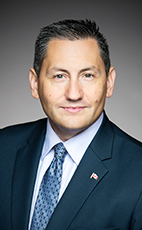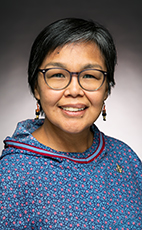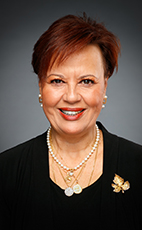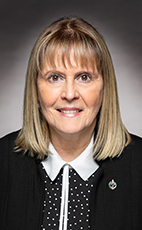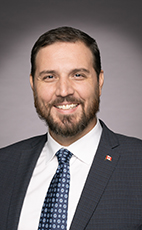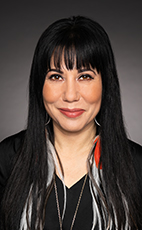44th Parl. 1st Sess.
September 16, 2024 11:00AM
- Sep/16/24 9:01:24 p.m.
- Watch
Madam Speaker, I thank the member for Saanich—Gulf Islands for her humanity and compassion, which she is displaying once again on this very sensitive topic.
I also want to take this opportunity to recognize a friend of mine who recently stepped down and who was co-leader with the member for Saanich—Gulf Islands. I wanted to pay tribute to him for his contribution to the debates. He is someone who truly believes in social justice. I wish Jonathan the best of luck in his new endeavours.
That being said, let us come back to the issue at hand. A very simple solution that the government could advance rather quickly would be to recognize the indigenous police forces as essential, to have them engage with the communities and to allocate predictable and adequate funding to them.
What does my colleague think of this ready-made solution for the communities?
152 words
- Hear!
- Rabble!
- add
- star_border
- share
- Sep/16/24 9:02:20 p.m.
- Watch
Madam Speaker, I thank my esteemed colleague, the member for Abitibi—Témiscamingue. I am deeply moved by his words about our friend, my old friend Jonathan Pedneault, who has now stepped down as my deputy leader of the Green Party of Canada. As my colleague put it so well, Jonathan always makes decisions with human rights issues front of mind.
I think my colleague from Abitibi—Témiscamingue is right. It is up to indigenous peoples to decide for themselves how best to protect their society. We need to hire indigenous people in law enforcement so that first nations can exercise their sovereignty. This issue affects all peoples in Canada.
As a non-indigenous person, I do not think I will ever trust the RCMP. I lived in small rural village in Cape Breton, and I know too well that the RCMP are not there to protect our lives.
154 words
- Hear!
- Rabble!
- add
- star_border
- share
- Sep/16/24 9:03:48 p.m.
- Watch
Madam Speaker, as I rise to speak at this emergency debate, I would like to take a moment to recognize the six indigenous people who lost their lives on whom this debate centres, specifically Steven Dedam, Danny Knife, Hoss Lightning, Jack Piche, Tammy Bateman and Jason West, and to acknowledge the trauma and loss that their families, friends and communities are suffering at this time.
Indigenous communities have faced some systemic injustices within the realm of law enforcement. The history of indigenous policing in Canada is fraught with challenges marked by a legacy of colonialism, discrimination and mistrust. Indigenous peoples have a unique cultural, social and historical context that must be recognized and respected in the realm of policing.
As we have witnessed time and time again, traditional methods of law enforcement often fail to adequately address the needs and values of indigenous communities. As a result, there is a pressing need for a paradigm shift in policing practices. I would like to focus a lot of my intervention tonight on the lack of commitment this government has toward community policing in northern, rural and remote areas, and its failure to support the first nations and Inuit policing program in the country.
For the information of those at home, and perhaps for some of my colleagues here in this House, Public Safety Canada manages and oversees the first nations and Inuit policing program, which was established in 1991. Under this program, policing services are provided either by the Royal Canadian Mounted Police, through community tripartite agreements negotiated by the federal government, provinces and/or territories and indigenous communities, or by communities' own police services under self-administered agreements.
Efforts toward indigenous policing must be guided by principles of reconciliation, cultural sensitivity and community empowerment. Part of the problem has been an Ottawa-knows-best paternalistic approach to the safety needs of indigenous people and indigenous communities. It is essential to engage indigenous communities in the design and implementation of policing strategies, ensuring that their voices are indeed heard and their perspectives valued, meaning a true partnership.
For too long, indigenous communities have borne the brunt of systemic injustices, including disproportionately high rates of crime and victimization. One of the most pressing types of criminality facing indigenous people on reserves is violence: domestic violence, sexual assault and homicide. Indigenous women are disproportionately affected by that violence, with rates of homicide and missing persons cases far exceeding national averages. These alarming statistics underscore the urgent need for targeted interventions, police and support services to address the underlying factors contributing to violence within indigenous communities.
Substance abuse and addiction are also significant challenges facing first nations people on reserve, contributing to a range of criminal behaviours including drug trafficking, poverty and crime. Intergenerational trauma and socio-economic disparities have contributed to high rates of substance abuse among indigenous populations. Addressing these underlying factors requires holistic, culturally sensitive approaches that prioritize healing, rehabilitation and community supports.
Overall, the Liberal government's drug policies have been catastrophic, with over 42,000 Canadians dying from drug overdoses. In British Columbia, where this Prime Minister carried out his hard drugs experiment, there has been a nearly 400% increase in overdose deaths. The Liberal Minister of Mental Health still refuses to acknowledge that the Liberals' dangerous policy was indeed a failure.
We must not only get tough on crime, especially when it comes to repeat violent offenders, but we must address the socio-economic disparities between non-indigenous and indigenous people.
Socio-economic factors such as poverty, unemployment and inadequate housing contribute to the vulnerability of indigenous people to involvement in criminal activity. Limited economic opportunities coupled with social isolation and a lack of access to essential service exacerbate the risk factors for criminal behaviour. Investing in education, economic development and infrastructure on reserves is crucial to addressing these systemic inequalities and creating opportunities for positive change within indigenous communities. These are all factors that a future Conservative government, with guidance from indigenous stakeholders, must tackle if we are to end the tragedies like the ones we continue to experience and to improve community safety and quality of life for indigenous men, women and children.
The challenges facing indigenous policing in Canada are multi-faceted and deeply rooted, from inadequate resources to entrenched biases, and these challenges continue to undermine safety, trust and the well-being of indigenous communities. Indigenous police services often face jurisdictional and legal complexities that impede their ability to fulfill their mandate effectively. The overlapping jurisdiction between federal, provincial and indigenous communities often creates confusion and delays in responding to issues on indigenous territories. One of the common complaints I hear is that provincial and federal police services will not enforce community bylaws. Clear protocols and agreements must be established to ensure seamless coordination and co-operation among all stakeholders in the justice system.
One of the foremost challenges is the chronic underfunding of indigenous police services. Many indigenous police services operate with limited resources, hindering their ability to adequately respond to emergencies, investigate crimes and provide essential services to their communities. This funding gap not only compromises public safety but also perpetuates inequalities in access to justice for indigenous peoples. Indigenous peoples deserve to feel safe in their communities. It is crucial that indigenous police services have the same powers as non-indigenous police services and have the proper and adequate resources to do the job they are expected to do, especially when it comes to the funding model, often done on a year-to-year basis. This makes it almost impossible for these police services to continue to plan, recruit and continue with officers who have experience.
Indigenous policing resources are stretched thin and face discrimination in Ottawa. In meetings with indigenous police services across the country, I have heard harsh criticism for the current model. Public Safety Canada would not fund specialized units like domestic assault, major crime, homicide or canine units, and it took a court case in June 2023 to declare that it was discriminatory and to throw those conditions out of the PSC agreements.
Thirty-eight per cent of indigenous police officers do not have backup while patrolling their communities. There are too few officers to keep up with the growing gang problems on reserves. Outside of Ontario, first nations' police officers do not have pensions, benefits and access to professional development. Indigenous officers make 25% less in salary than their non-indigenous colleagues.
In 2023, the Treaty Three Police Service, the Anishinabek Police Services, and the United Chiefs and Councils of Manitoulin Anishnaabe Police had to take the government to court over discriminatory terms and conditions in their service agreements. Together, these first nations police organizations serve 45 first nations communities and around 30,000 people across northern Ontario, and they had to operate on a line of credit while the government dithered, putting the communities and people at risk.
In 2022, after the mass killing at James Smith Cree Nation in Saskatchewan, the Prime Minister promised to work toward making indigenous policing an essential service in Canada. However, here we are now, nearly three years later, with, sadly, no changes. In 2020, the Liberals promised to bring forward legislation to declare first nations and Inuit police services an essential service, and yet, still nothing. The National Inquiry into Missing and Murdered Indigenous Women and Girls calls for justice, section 5.4, called for immediate and dramatic transformation of indigenous policing, including civilian oversight bodies to audit and investigate claims of police misconduct. That was almost six years ago and still counting.
In 2024, the Auditor General's office released a damning report on the status of first nations and Inuit policing in Canada. The first nations and Inuit policing program is a cost-sharing program. About 52% of its funding comes from the federal government and 48% comes from the provinces or territories.
The Office of the Auditor General found several glaring issues with Public Safety Canada's management of the program. Despite funding increased to this program, the Office of the Auditor General found that $13 million of the funds earmarked for the 2022-23 fiscal year went unspent. As of October 2023, Public Safety Canada expected that over $45 million in program funding would be left undistributed for that fiscal year.
The OAG also found that Public Safety Canada had poorly managed the program. Specifically, it found that Public Safety Canada had poor fiscal management oversight, had limited expansion of the program despite additional funding, lacked an approach to support equitable funding decisions, lacked consistent engagement and partnership with communities, and lacked the information to measure the program's effectiveness.
Furthermore, the RCMP did not consistently deliver on its responsibilities under that program. Specifically, the RCMP had an insufficient number of officers in dedicated communities, no requirement for culturally specific training to understand the culture of the community being served, inconsistent implementation and monitoring of whether policing services promote partnership with communities, and no information on program effectiveness.
I should note that the RCMP is not party to community tripartite agreements. Public Safety Canada signs these agreements with the provinces and territories, and between first nations or Inuit communities, without bothering to confirm that the RCMP actually has the ability to meet the terms of the agreement. If that does not define a failed Ottawa-knows-best approach, I am not sure what does.
In fact, this past April, at an indigenous and northern affairs committee hearing, Public Safety Canada indicated that it is currently in the process of co-developing federal legislation intended to recognize first nations policing as an essential service. During her testimony before the committee, one of the directors of the Office of the Auditor General noted that the new legislation is intended to apply only to self-administered agreements and not to community tripartite agreements.
This means that the communities, under tripartite agreements, that are policed by the RCMP and municipal police forces would not be regarded as essential, which is the key to this whole issue. For context, there are only 36 self-administered police agreements in Canada. That would leave the vast majority of first nations and Inuit communities without the essential designation for police services.
Historical trauma and intergenerational mistrust continue to cast a shadow over indigenous communities and the RCMP, including, where applicable, municipal police relations. The legacy of colonialism, forced assimilation and residential schools has left deep scars on indigenous communities, contributing to a profound mistrust of authority figures, including the police. Rebuilding trust and repairing these relationships will require genuine efforts at reconciliation, acknowledgement of past wrongs and meaningful engagement with indigenous communities in the development of policing policies and practices.
In addition, a future government plan on indigenous policing must prioritize the recruitment, training and retention of indigenous officers. Representation matters. It matters deeply in law enforcement. Indigenous peoples deserve to see themselves reflected in the institutions that serve and protect their communities.
Additionally, indigenous policing initiatives should prioritize restorative justice approaches, with an emphasis on healing, rehabilitation and community cohesion over punitive measures. Traditional indigenous justice practices offer valuable insights into resolving conflicts and restoring harmony within communities. This does not mean there are not consequences for crime, but those consequences reflect historical and traditional indigenous community responses to those crimes. Where appropriate, these alternative justice incentives could have real and lasting positive outcomes for indigenous communities.
One of the key strengths of restorative justice lies in its emphasis on dialogue and relationship building. By bringing together victims, offenders and community members in a safe and supportive environment, restorative justice fosters empathy, understanding and mutual respect. Through open and honest communication, individuals can confront the harm done by those actions, take responsibility for their behaviour and work toward repairing the harm done.
Moreover, restorative justice practices have been shown to be effective in reducing crime rates and promoting long-term community safety, and we do that by addressing the root causes of crime and the needs of all affected parties. Restorative justice helps to break the cycle of violence and create a more just and comprehensive society.
As I conclude, I would like to leave us all with this, which I have said a few times in my speech. Many indigenous communities have a fraught history with external law enforcement agencies. It is marked with experiences of discrimination, violence and systemic racism. Indigenous-led policing helps to address these historical grievances by involving community members directly in the process of maintaining safety and order. This approach helps to rebuild trust, making it more likely that community members will engage positively with law enforcement and co-operate in matters of public safety.
Traditional law enforcement methods can sometimes fail to address the root causes within indigenous communities. Indigenous-led initiatives, on the other hand, can incorporate culturally relevant practices and community wisdom. This approach can lead to a more sustainable solution to crime and conflict, tailored to the specific needs and values of a community. When indigenous people can serve as police officers within their own communities, it empowers them to take that active role in shaping their own futures. This representation, as I said before, is absolutely crucial because it ensures that the policies and practices of law enforcement reflect the values and needs of indigenous peoples.
It also provides a role model for younger generations, inspiring them to envision and work toward leadership roles in their own communities. Their cultural competence allows them to navigate complex social dynamics with a sensitivity that external officers might lack. For example, indigenous officers are more likely to understand and honour traditional practices and customs, which can be crucial in resolving conflicts and engaging with community members in a respectful manner. This cultural insight prevents misunderstandings and fosters a policing approach that is both empathetic and effective.
In conclusion, acknowledging the historic injustices faced by indigenous peoples is essential for building a more equitable society. In investing in these indigenous-led police services, we would take concrete steps to address these injustices and contribute to the reconciliation process. This support demonstrates a commitment to repairing relationships and fostering understanding between indigenous communities and the broader societies. Indigenous policing in Canada is not merely a matter of policy; it is a moral imperative. It is a testament to our commitment to justice, equality and reconciliation. Together, let us work toward a future where indigenous policing reflects the values and aspirations of all.
2417 words
- Hear!
- Rabble!
- add
- star_border
- share
- Sep/16/24 9:22:30 p.m.
- Watch
Uqaqtittiji, I am actually quite confused by the member's intervention because what he spoke about goes against a lot of what the Conservatives' messaging is, including always talking about being tough on crime and all those kinds of things.
I wonder if the member can describe for us how he will try to influence his party to commit to ensuring that what he said is something all of his caucus will work hard on from now on, because part of what has led to this emergency debate today is not just broken promises but cutting funding to important programs when the Conservatives were in government, specifically national crime prevention centres in Canada, as well as the Aboriginal Healing Foundation. That was so hurtful, especially because a Nunavut Conservative MP was the minister and it was the Conservatives who cut that important program.
How can we reconcile what you are saying, and what will you do to make sure your full caucus would implement what you are envisioning as better policing for indigenous peoples?
174 words
- Hear!
- Rabble!
- add
- star_border
- share
- Sep/16/24 9:24:07 p.m.
- Watch
I understand the hon. member's emotions, but I did not intervene or say anything.
The hon. member for Haliburton—Kawartha Lakes—Brock.
25 words
- Hear!
- Rabble!
- add
- star_border
- share
- Sep/16/24 9:24:17 p.m.
- Watch
Madam Speaker, I will try to answer as much of the member's question as I can. I wrote down notes. Hopefully I have it all.
As the critic for Crown-indigenous relations and indigenous services for the opposition, it is part of my job, my mandate, to develop policy that will be put into our next election platform. I note that some of the things I mentioned today were from previous policy documents that we had released in previous elections. They talk about giving more power to indigenous police services and essential services, about funding them correctly and about restorative justice practices. Something our party, myself and others on this side of the House are talking about today is the direction our party is moving in regarding indigenous justice and indigenous policing.
I mentioned funding, as well as essential services and ensuring that the “Ottawa knows best” approach is not the one we continue to lead by. It has to be grassroots-led and about listening to the voices that are telling us what their issues are. That goes to the justice piece of my speech when I was talking about how each individual community might have different visions of how they wish to run a justice system, whether it is through restorative justice, through their law enforcement and policing side or through indigenous police services. Perhaps they want other aspects of the law enforcement angle.
Giving power back to these individual communities is key, but to the member's point, as I talked about, it is about ensuring proper funding so that we do not have an unlevel playing field between indigenous and non-indigenous police services or even in the justice system in general.
289 words
- Hear!
- Rabble!
- add
- star_border
- share
- Sep/16/24 9:26:16 p.m.
- Watch
Madam Speaker, there was much in the hon. member's speech that I agreed with. When it comes to funding first nations policing, I would remind the hon. member that when the Harper government Conservatives were in power, first nations policing was grossly underfunded. One of the first things the public safety minister did was engage on that.
In 2018, $291 million was put into first nations policing, and in 2021, there was another $540 million. The hon. member talked about how not all of that money was spent, but he also talked about the importance of engaging with communities. I hope he would agree that these programs for first nations policing need to be led by indigenous peoples, as does the co-development of legislation. These are hard things to do that require hard work, and sometimes they require time.
I am wondering if the hon. member will commit that his party will support these additional funding investments and will ensure that first nations policing is co-developed with indigenous peoples and the Assembly of First Nations, not just dictated to them by the federal government.
187 words
- Hear!
- Rabble!
- add
- star_border
- share
- Sep/16/24 9:27:37 p.m.
- Watch
Madam Speaker, the crux of my speech was about how we need to level the playing field between indigenous police services and non-indigenous police services. During my speech, I mentioned the disparities in wages, benefits and training. Those are all pretty important things when talking about policing, and not only with recruitment but with retention. I mentioned the funding model and that many of these police services, like the ones in northern Ontario, were on year-to-year contracts. The deadline for their funding lapsed and they had to run police services on a line of credit. That was pretty troubling to the chief of police and members themselves. They were trying to police 30,000 people as indigenous police services, and they did not even know if their funding was going to continue. As for making it an essential service, I mentioned that a few times in my speech. My answer to the NDP talked about that as well.
I agree with the member that these things do take time, absolutely. In 2022, the Prime Minister promised to work toward making indigenous police services an essential service, but it is three years later and still nothing has happened. The Liberals have been in power for nine years. The Auditor General came out with a report that said some pretty important things needed to be addressed in addition to policing, and here we are talking about them because some tragedies have happened. We need to accelerate this conversation.
249 words
- Hear!
- Rabble!
- add
- star_border
- share
- Sep/16/24 9:29:22 p.m.
- Watch
Madam Speaker, we are taking part in a very important emergency debate this evening at a time when six people have died and violence is on the rise.
I would therefore like to know what solutions a Conservative government would propose. I would also like to know if such a government could build good relations with indigenous communities and implement the recommendations of the report of the National Inquiry into Missing and Murdered Indigenous Women and Girls that have not yet been implemented.
83 words
- Hear!
- Rabble!
- add
- star_border
- share
- Sep/16/24 9:29:54 p.m.
- Watch
Madam Speaker, the work we in the opposition have been doing with indigenous communities and leaders shows our commitment to listening to voices on the ground level and reducing and hopefully eliminating this “Ottawa knows best” approach.
We have already announced a number of policies that will take control of communities away from Ottawa through a resource charge, which will allow communities to keep the tax revenue generated on their land rather than sending it to Ottawa. We will announce many more. However, the crux of my speech was about getting rid of the “Ottawa knows best” approach because it has not worked for 155-plus years. If we continue on this path, it will not work for another 155 years, and we will continue to have these conversations.
We need to provide optional legislation, if needed, for those who want to do different and unique things, and strip down the “Ottawa knows best” bureaucracy that continues to fail indigenous people. One part of this is listening to the voices that want to empower indigenous people to become police officers through indigenous police services, but we need to ensure that they are on a level playing field and not handcuffed when they need to do their jobs appropriately.
214 words
- Hear!
- Rabble!
- add
- star_border
- share
- Sep/16/24 9:31:37 p.m.
- Watch
Madam Speaker, I appreciate the speech that my colleague from Ontario gave, and I thank him for the significant amount of work he has done with indigenous leaders and communities across this country.
I am wondering if he could share with this House some examples, even sometimes born out of the ashes of tragedy, where spaces or opportunities for reconciliation have come about and indigenous communities have seen relationships restored. Are there instances with indigenous police where productive relationships are built and where high-quality policing is able to support victims? I know that my colleague has had many conversations, both tough ones and a number of encouraging ones, on that.
111 words
- Hear!
- Rabble!
- add
- star_border
- share
- Sep/16/24 9:32:42 p.m.
- Watch
Mr. Speaker, I will give a good, positive example from what the province of Alberta is doing, because it often leads the way when dealing with indigenous communities. We can look at what the Siksika are doing. They are working to build their own justice system. In fact, I believe construction on a new courthouse has already started where they will be able to implement their own restorative justice practices.
We can look at what Alberta has done with police service contracts. We were talking about those doing one-year contracts, but Alberta in many cases is moving toward three-year funding models, which give some predictability to indigenous police services.
Alberta is moving in that direction, and I think other provinces and the federal government need to do the same, because the conversation has been going on too long. We need to see action. Listening to the voices on the ground is exactly what we need to be doing more of.
162 words
- Hear!
- Rabble!
- add
- star_border
- share
- Sep/16/24 9:33:54 p.m.
- Watch
Mr. Speaker, I will be sharing my time with the member for Winnipeg Centre.
Before I begin, I would like to acknowledge that Canada's Parliament is located on the traditional unceded territory of the Algonquin Anishinabe people.
In less than one month, Canada has become witness to the tragic deaths of no fewer than six people from first nations communities across our country. Although the circumstances in each incident varied as greatly as their age ranges, with the youngest among them just 15 years old and the eldest 57, common to all of them was their involvement in police-related incidents in the final moments of their lives. Tragically, these are not the only examples of these incidents. We do not have to look far in the media, in cities and in towns from coast to coast to coast to find other examples of people from first nations communities who have died in similar incidents. Make no mistake that each is a tragedy and each speaks to deeper and more widespread problems that exist here in Canada.
Indigenous Services Canada and Crown-Indigenous Relations and Northern Affairs Canada are not policing agencies. The mandate and authority related to the administration of the justice system in Canada are not within their purview. These departments, on the other hand, do have an important role to play in building a new relationship with indigenous peoples and in promoting their well-being and safety. This is a priority for these departments and for the Government of Canada.
The primary objective of these departments is supporting indigenous peoples in their efforts toward self-determination and empowering them in shaping the future of their communities. That mandate includes ensuring that indigenous peoples and communities have access to the services they require, including health, education and social services. Our vision is one in which indigenous peoples independently deliver services and address the socio-economic conditions in their communities.
The administration of justice, which includes policing and enforcement, is a topic of discussion at a number of tables across the country, led by Crown-Indigenous Relations and Northern Affairs Canada, that are looking at ways of recognizing rights and self-determination. We support a way forward on a rights-based approach while being mindful that policing is one element of the broader justice system. Given this, there are immediate needs and longer-term goals, as well as opportunities to proactively address some of the gaps identified through reports, recent engagements, consultations and even litigation.
I am happy to hear my colleagues on both sides of the House speak about emergency measures that will save lives in situations similar to those we have been discussing this evening. I hope that such proposals, if they can be feasibly deployed, will make a meaningful difference, a difference of life and death, it is fair to say, in future encounters between people from first nations communities and law enforcement professionals.
I would like to touch upon some of the programs that Indigenous Services Canada has co-developed with the support of leaders from indigenous communities across the country. The first is the pathways to safe indigenous communities initiative. Community services are an important part of supporting community safety and well-being. Indigenous Services Canada helps first nations, Inuit and Métis communities and partners, both on and off reserve, to implement indigenous-designed projects that improve community safety and well-being. I stress that these projects are not designed and led by officials from the Government of Canada. Rather, they are developed by indigenous partners to create a broad spectrum of community support.
The pathways to safe indigenous communities initiative is providing $120 million over five years between 2021 and 2026 to assist first nations, Inuit and Métis communities and partners, both on and off reserve, to implement indigenous-designed projects to improve community safety and well-being. This initiative supports projects that recognize the importance of traditional knowledge and practices that contribute to greater community safety and well-being, recognize holistic models of community safety and well-being and address existing and emerging needs related to the safety and well-being of indigenous women, girls and 2SLGBTQI+ people.
Most of the initiatives we have heard about today are led by Public Safety Canada and administered through the department's first nations and Inuit policing program, or FNIPP. I will, however, say that Indigenous Services Canada and Crown-Indigenous Relations and Northern Affairs Canada play a supportive role in the matter of indigenous policing by giving advice to Public Safety on the engagement with indigenous communities on policing legislation.
The FNIPP was created in 1991 with the aim of enhancing community policing services, supporting culturally responsive policing in first nations and Inuit communities and recognizing input from indigenous communities of policing services received. Indigenous peoples, like all people in Canada, have a right to receive culturally appropriate and respectful police services, and contributing to safer and healthier indigenous communities is a priority for the Government of Canada.
The United Nations Declaration on the Rights of Indigenous Peoples Act Action Plan commits Canada to leveraging the FNIPP and engaging and working with indigenous communities and with provinces and territories on approaches to enhance policing services that are professional, dedicated, and responsive to first nation and Inuit communities. The costs to run the program are shared between the federal government and the province or territory, while provinces and territories have jurisdiction over operational policing requirements and priorities, and the federal government acts as a funding partner. I am pleased to say that the FNIPP has resulted in dedicated, culturally responsive policing services being established in many first nations communities that would not otherwise have a dedicated on-site policing presence.
The federal government is committed to building on the success of this program. Budget 2021 announced up to $540 million over five years beginning in 2021-22 and $126.8 million ongoing to support Indigenous communities that are currently served under the FNIPP and to expand the program into new communities. With this funding, the Government of Canada has been working with first nations and Inuit communities and with provinces and territories to address priority needs.
Work is already under way on several other key related initiatives, such as to co-develop legislation that would recognize first nations police services as essential services, to work with provinces and territories to identify improvements to program governance with a view to delivering funding faster, and to revisit the program management relationship with the RCMP to ensure that officer availability is more readily considered and integrated in program management decisions. In addition, the Government of Canada has committed to supporting improved community police relations by working with first nations communities, provinces and territories to support community safety officer projects and community police discussions.
At the status of women committee, we heard from countless indigenous women and girls during our study on the red dress alert. Most of them do not trust the police, and there is a lot of work that still needs to be done, regardless of what has already been done. There are several communities that are examples to follow, in which the community is quite close and has built a relationship with the police, and where the police have made an effort. However, there are very few examples, and across Canada a lot more work needs to be done.
I mentioned at the outset of these remarks that Indigenous Services Canada and Crown-Indigenous Relations and Northern Affairs Canada are not policing agencies. They are not mandated or authorized to provide the types of community services that are performed by law enforcement officials. What we can do, on the other hand, is to provide supports for those professionals and to remember the first nations communities from coast to coast to coast to ensure that people are safe in their homes and in their neighbourhoods.
The Government of Canada takes the issue of indigenous safety and well-being very seriously. We are committed to walking the shared path of reconciliation with indigenous people and will continue to work in partnership with first nations and Inuit people and organizations, as well as our external partners, to develop effective solutions. Our end goal is to make sure indigenous peoples from coast to coast to coast are safe and adequately housed. It is also about building capacity, developing skills and providing supports on the ground so indigenous communities can reach their full potential.
Meegwetch.
1420 words
- Hear!
- Rabble!
- add
- star_border
- share
- Sep/16/24 9:42:29 p.m.
- Watch
Uqaqtittiji, I do appreciate some of the things the member shared regarding some of the work that is going on, but there are a lot of gaps still that are happening. Some of it, I think, is very much policy-driven, because I cannot see it being legislated as part of a rule of law. I would like to ask, for example, about criminalizing land defenders. The RCMP is famous for enforcing policies that criminalize land defenders, like the Wet'suwet'en chiefs in B.C.
I wonder whether she can share with us what the Liberal government envisions about ensuring that we are doing less to criminalize indigenous peoples, while making sure that we are doing a better job of protecting indigenous peoples' rights and their inherent right to protect the environment.
133 words
- Hear!
- Rabble!
- add
- star_border
- share
- Sep/16/24 9:43:38 p.m.
- Watch
Mr. Speaker, I believe that there is no one better in the House to provide input. I think that the government should listen, and that is the whole point. The thing is that communities, indigenous communities, need to be the ones at the forefront, letting the government know what exactly is needed in order to create a safe space and environment for them.
I know that the government has already opened up consultations. It has made that relationship stronger, and I hope that the government continues to do that. I know that is the intention of the government.
98 words
- Hear!
- Rabble!
- add
- star_border
- share
- Sep/16/24 9:44:29 p.m.
- Watch
Mr. Speaker, I know that the hon. member has done a lot of work on the status of women committee, and one of the studies we did there was on indigenous women in the criminal justice system. That was quite a few years ago. I just wonder whether the hon. member could talk about the impact of colonial policies on indigenous women and girls, and the impact they are having on their interactions with the police. I believe that the member for Winnipeg Centre was saying that today the red dress alert study was tabled in the House, and perhaps the hon. member could talk a bit about that as well.
111 words
- Hear!
- Rabble!
- add
- star_border
- share
- Sep/16/24 9:45:14 p.m.
- Watch
Mr. Speaker, yes, that is the case. On the committee, we have done a lot of work to better the relationship between the government and these women and girls who suffer more than anybody else in the country and who are victimized more often than anybody else in the country. This is something we need to take extremely seriously.
The fact is that the current laws we have in our country are not necessarily the ones that are protecting these women and girls the most, and I think we need to do a lot more work in order to listen to what they need. One of the things we heard coming out of the study was that this needs to be indigenous-led. It cannot be led by the Government of Canada; it really needs to have the input of indigenous leaders and indigenous women and girls who know what they need in order to be safe and who can really give input. Without that input, we will not make the positive changes, and we have been making positive changes because we have been listening. I hope that continues.
189 words
- Hear!
- Rabble!
- add
- star_border
- share
- Sep/16/24 9:46:31 p.m.
- Watch
Mr. Speaker, one of the things I have been encouraged by is a local group, a club that I made reference to earlier, the Bear Clan Patrol, which is very well established. For many years they have had different levels of government and different political parties participate in some of the patrols that are taking place
One of the single best things I see that it has accomplished is bringing community members and improving relationships with community members along with elected officials and law enforcement agencies. In fact, it is more than just one law enforcement agency. It has attracted a great deal of attention in North America, and I am wondering whether the member can just provide her thoughts in regard to how community initiatives can help advance reconciliation by bringing the different stakeholders together.
136 words
- Hear!
- Rabble!
- add
- star_border
- share
- Sep/16/24 9:47:34 p.m.
- Watch
Mr. Speaker, I believe that any initiatives that bring the communities to the elected officials to let them know what exactly their communities need are going to be beneficial, and that is the key. It is really about communication. Indigenous-led initiatives are the ones that are going to make a difference within their communities.
Here in Ottawa, we do not necessarily know what people in their communities back home are needing, and obviously we are not necessarily responding to all of their needs right here in Ottawa. We need to hear from them. We need to make those channels more readily available, so any initiatives that make that communication easier are going to be beneficial.
116 words
- Hear!
- Rabble!
- add
- star_border
- share
- Sep/16/24 9:48:26 p.m.
- Watch
Mr. Speaker, I would like to start by thanking my good colleague, the member for Nunavut, for requesting this emergency debate. I also want to give a shout-out to my good friend and colleague Kim Pate, on the Senate side, who has done tremendous work in this area as well.
This is a topic, as we know, that is often neglected by politicians, and quite frankly the media normalizes systemic violence against indigenous people. Police brutality against people of colour, particularly indigenous people and Black people, BIPOC people, is nothing new in this country. However, recently the extent of police violence against indigenous people has grown to such a shocking level that it cannot be ignored by our leaders.
Given that it is our duty to promote reconciliation, the federal government must end the ongoing legacy of settler violence that is being perpetrated through police brutality, and I want to give some examples of that. Between 2017 and 2020, an indigenous person in Canada was 10 times more likely to have been shot and killed by a police officer than a white person was. The Canadian Civil Liberties Association recently reported that while indigenous people make up 5.1% of people living in Canada, they represent 16.2% of people killed in police-involved deaths.
There is no centralized, updated data set that exists that tracks deaths and provides information about the person, location, implicated police service, type of force used and many other contextual details. Much of what we rely on to understand these cases are “official documents” like police oversight body and media releases that contain limited details and tell only a one-sided police narrative, which is something that has often been cited and complained about by the public in Winnipeg with its current independent investigation unit.
Researchers have also found that the use of lethal force by police was on the rise, especially since the start of the pandemic, between 2011 and 2022. Lethal force was 66.5% higher than in the previous decade, with indigenous and Black people being disproportionately impacted.
I share this because it is nothing new. In fact in the last two weeks, we witnessed six cases of police brutality resulting in the deaths of indigenous people. This included cases of unnecessary force in response to people undergoing things like mental health crises; negligence resulting in the death of an unhoused person, like what I witnessed in Winnipeg; a photo of an unsheltered woman being removed by six patrol officers for sleeping on a bench in Winnipeg; and the lethal force used against a 15 year old. To me, it is unconscionable that our society is treating people made most vulnerable by systems with violence rather than uplifting them and treating them as human beings.
I want to give my sympathies to the latest victims' families, and I want to say the victims' names. We must say their names, because they were human beings who were deserving of respect, dignity and human rights, something that was robbed from them and in turn hurt families and those who are left behind. They are Jack Piche, age 31; Hoss Lightning-Saddleback, age 15; Tammy Bateman, a woman in her 30s; Jason West, age 57; and Steven Dedam, age 33.
However, as I said, this is not anything new. In fact, in April 2020, in the city of Winnipeg, three indigenous people were killed in a span of 10 days: Eishia Hudson, age 16; Stewart Kevin Andrews, age 22; and Jason Collins, age 36.
In these cases, the Independent Investigation Unit of Manitoba laid no criminal charges. It is a unit that has been criticized by the hon. former senator Murray Sinclair.
Today, just before coming to the debate, I spoke to the family of William Walter Ahmo, who was incarcerated in a provincial jail. The violence against indigenous people does not just happen on the streets with police; it also happens within our penitentiaries. On February 7, William Walter Ahmo had an emotional breakdown after a guard made a racist comment toward him.
Racism is so normalized in our justice system that indigenous people such as the Wet'suwet'en have to listen to racist comments from the RCMP. The Winnipeg city police said it was up to indigenous people to search for their loved ones in a landfill. It was up to us.
It could come from a current city councillor or the officer on guard in the prison making a racist comment to William, a young man struggling with mental health and dealing with intergenerational trauma, and he responded. Fourteen guards brought him down to get him under control, and as a result of excessive force, he lost his life.
This evening I asked his mother, “Can I share your words?” She said, “Do you know how it felt having to watch my son lose his life? It was like having an out-of-body experience, watching my son yell over and over and over again, 'I can't breathe. I can't breathe. I can't breathe'.”
The chief medical examiner ruled it a homicide. The Court of King's Bench let the guards off.
This is a system that is broken, and the result of these persistent cuts and underfunding of vital social services fall the hardest on indigenous people. For example, Iggy Dedam was the third indigenous person in recent years to be shot and killed by police during a wellness check in New Brunswick. Had he been provided with the health care supports he needed, he probably would be alive today.
In the city of Winnipeg, Tammy Bateman was hit by a police cruiser driving through an encampment at Fort Rouge Park. Putting aside the gross negligence of the officer driving the cruiser, we again see the impacts that the housing crisis has had on indigenous people, many of whom lack a home they can find safety in.
During question period, I asked the Liberal government why the Liberal government is failing to honour its legal obligation to fund health services to first nations youth through Jordan's principle. According to Cindy Blackstock, there are between 40,000 and 80,000 Jordan's principle requests that Indigenous Services Canada has not processed or opened. When first nations children and youth are denied health services they desperately need, they are more likely to encounter police rather than health care professionals when undergoing a mental health crisis, and this is costing lives.
This is not another tragedy: This is elected officials willfully turning a blind eye on a system filled with systemic racism in policing and at all levels of the justice system.
As the late Cathy Merrick said when speaking about William Ahmo's case, “This justice system was not meant for us.” I want to honour the late Grand Chief Cathy Merrick this evening.
1155 words
- Hear!
- Rabble!
- add
- star_border
- share




